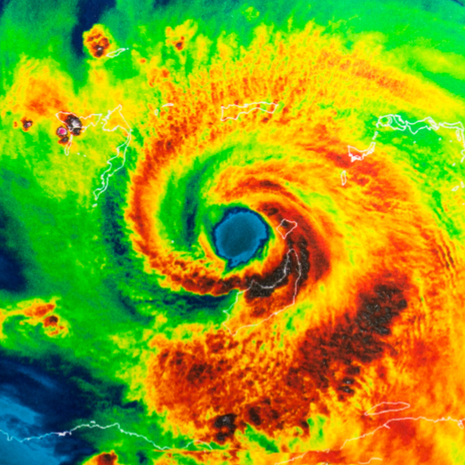“Rush hour in Big Sur, Calif. has taken on a whole new meaning,” writes Kirk Siegler in his latest NPR article entitled “Commuting By Foot: Big Sur Residents Struggle With Life After Mudslide.”
We could quickly tell this was weather related – something you can relate to, right?
According to Siegler’s article, “Most mornings and afternoons, a newly built footpath that plunges through a grove of towering redwoods is clogged with workers and school kids.”
“That hiking trail is a lifeline. It circumnavigates a bridge on the Pacific Coast Highway that's been closed since February, after it collapsed from rain and mudslides. Without that path, much of the village of Big Sur would be cut off from the outside world,” the article continues.
This statement hit us hard and got us thinking about the effects of weather. It can have a great impact on states, cities, towns, and certainly your property.
Siegler writes in his NPR piece that “a 60-mile stretch of rugged, central California coastline between San Francisco and Los Angeles, Big Sur was hammered by 100 inches of rain this past winter, falling on steep mountainsides ravaged by drought and fires.”
100 inches of rain? We could only imagine the consequential damage.
It makes us nervous, especially with the potential damage adverse weather could do if it slams your city and property.
What would you do? How would you manage this emergency? Do you have processes in place to mitigate this?
Are you StormReady like one of our proactive clients, the Nashville Predators?
And let’s not forget, right now is a nerve-racking time for our Atlantic coast properties as hurricane season started June 1st and will go to the end of November.
We know we need to prepare you.
Keep reading; we’re going to share some insight on how to be proactive when adverse weather comes your way.
Weather Strategies to Keep Guests Safe
Below are highly recommended steps for managing the impact of severe weather on your property.
It’s time to keep the tens, hundreds, and even thousands of guests you’re charged with protecting, safe.
Whether you have guidelines in place already, are looking for a benchmark to get started, or plan to become Storm Ready, we all must anticipate Mother Nature’s fury.
Here are some ways to be ready for adverse weather threatening your property:
Event Day Policy
- Upon determining that weather conditions will threaten the safety of guests and participants at an event, your Command Post operator will contact the Manager on Duty (MOD) and the Incident Management Team and the Event Promoter (that is, if time permits) to advise accordingly.
- The Command Post will inform the police department and event security to prepare to assist guests to move under shelter or to evacuate.
Move to Shelter
- A public announcement will inform the guests of the threatening situation and their option to leave the property.
- Guests will be advised of safe areas to seek shelter on the property should such areas be available.
Evacuation Order
A public service announcement (PSA) will notify guests that a report of pending weather problems requires the event be canceled.
- Upon notice of evacuation, all security, ushers, maintenance, police, and fire rescue personnel shall go to their assigned evacuation posts.
- All food and merchandise vendors shall close their stands, secure their inventory and lock their cash drawers. Upon stand closure, all vendors shall exit the property to a particular location and assemble for headcount.
Relocate Personnel to Gates
- Proceed to assigned gates as if the event were about to end, and open the gates. If a gate key is not available, one can be obtained from the event staff supervisor.
- Ensure that all gates are open. All turnstiles should be closed.
- Direct guests out of the property and make sure that guests do not re-enter the property.
Concourse Personnel
- Position themselves near each exit from the seating areas as if the event were about to end, and assist in directing guests out of the property to the closest exit as quickly and efficiently as possible.
- Upon being relieved, reassemble with the supervisor at a particular location for headcount. Attendance will be taken.
Personnel at Ramps & Elevators
- Position themselves at each exit to the ramps as if the event were about to end, and assist in directing guests out of the property as quickly and efficiently as possible.
- Calmly advise exiting guests that the escalators will not be working during an evacuation. The ramps must be used.
Seating Area Personnel
- Respond to the front of your section as if the event has ended.
- Direct the guests out of their seating area toward the nearest exit as quickly and efficiently as possible.
- Assist the physically challenged.
- Advise any physically challenged in your area that in the case of an evacuation, the elevators will not be in service.
On-Field Event & Security Personnel
- Assist the police department with escorting officials from the field.
- Secure all playing field entrances to the ground level tunnel.
- Ensure that no one is allowed to re-enter the playing field except authorized personnel.
- Upon all the staff and officials exiting the property, and being relieved, reassemble with your supervisor for headcount.
Parking Operations
- Parking operations should prepare to open all exit gates as if the event has ended.
- Parking operations should stand by for directives from the command post concerning blocking off the gate(s) and sections of the property perimeter road for use by emergency vehicles.
- Upon all vehicles leaving the property, parking operations will reassemble with supervisors for headcount.
Now let’s say the weather passes your property.
Wet patches will most likely remain, right? This scenario means incidents such as wet spills can occur. These can quickly escalate to major medical issues from a slip & fall.
You need to trust that your team handles the aftermath appropriately. Train them well to keep your guests and themselves safe during the entire event.
Here’s what to do next.
Expertly Train Your Team
Professionally train your team to execute these adverse weather methods.
They’ve got to be ready for anything!
Set your team up for success.
Develop their knowledge of your property’s guidelines. Show them how to mitigate incidents that stem from the after-effects of bad weather.
Be the ‘proactive leader’ they require.
Use tabletop exercises to run real-life practice scenarios using the methods above while asking and answering the seven questions below.
- Do employees have the muscle memory to be proactive rather than reactive in any critical situation?
- Can employees identify potential hazards before they occur or escalate?
- Who do they communicate with first when an incident such as a slip and fall occurs?
- How do they handle a scenario where someone is injured during an evacuation?
- Does your team know how to use the incident management mobile app to follow protocols to handle?
- Can your team communicate with the command center and others effectively?
- How efficiently can they report an incident using your mobile app?
Deliver the safest experience. Practice like everyone’s life depends on it.
Now, we’re going to show you how to augment your ability to keep everyone safe with a solution during weather-related scenarios.
Incident Management Systems Supplement Your Initiatives
Training your employees on the procedures above is a good practice.
But, don’t rely on them to recall every aspect of their training. Certain types of situations don’t always happen, which means they’ll likely forget how to perform.
You need everything communicated effectively. You also need your team to execute these protocols efficiently.
Put the right incident management infrastructure in place to get real-time data and have communication throughout all your departments.
Because real-time communication is the only way to receive real-time data. It’s especially important during severe weather or any emergency for that matter.
You must eliminate poor communication and how it affects the safety of your guests.
How do you accomplish this?
Incident management software helps your team communicate and understand the information needed during weather-related events.
Don’t stop there, though.
Mobile Apps Are Now a Must-Have for Proactive Operations
Enhance your system with incident management mobile apps. These apps will help your command center communicate protocols efficiently.
- Your frontline staff can report incidents in seconds.
- You’ll have all the associated event information in your system.
- With a couple of clicks of a button, the information will be transmitted to your entire team.
- Your mobile staff can even communicate on the fly with your command center personnel.
What does all of this help you achieve? Faster response times.
Everyone is being notified simultaneously and without communication bottlenecks. The system captures all of the actions associated with an incident.
Then, it communicates proper protocols to your teams.
Let’s say that a high priority incident occurs as a result of your most recent evacuation.
Your staff doesn’t hesitate with an implemented system.
- All of the need-to-know information populates on employees’ mobile device.
- Your team takes action.
- They mitigate the incident and your evacuation proceeds.
How’s this result for Proactive Operations? How professional does your team look? We think you know the answer.
Do you see how having all of the following safeguards in place can help you prepare your property for unfavorable weather?
- Methods for managing weather-related scenarios
- Expertly trained and high-performing employees
- Incident management software to coordinate your efforts
- Incident management mobile apps to boost mobile teams efficiency
This preparation is how you prevent weather from battering your operation.
So, are you ready now?
Over to You
It’s terrifying to think of the long-term impact adverse weather can have on communities – and your property. The bottom line is that you must be proactive in keeping your guests safe. That’s first and foremost.
Use these guidelines to jumpstart your proactive operation. Utilizing them will put you on the right path to become StormReady officially.




